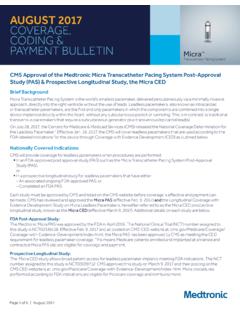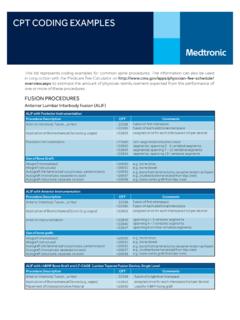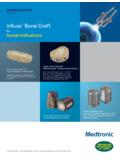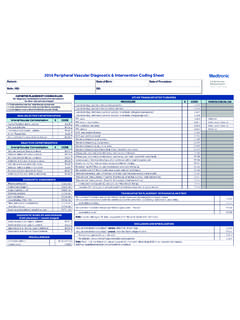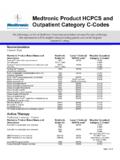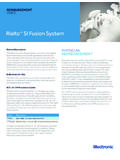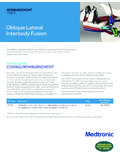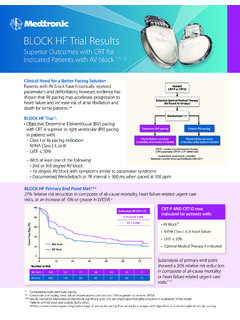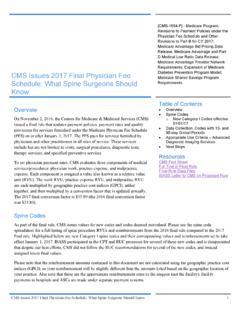Transcription of Pipeline Flex Embolization Device Coding and …
1 Pipeline FLEXEMBOLIZATION DEVICECODING ANDREIMBURSEMENTGUIDEThe Pipeline flex Embolization Device is a braided, multi-alloy cylindrical mesh indicated for the endovascular treatment of adults (age 22 and above) with large or giant wide-necked intracranial aneurysms in the internal carotid artery from the petrous to the superior hypophyseal segments. The Pipeline flex Device is intended to treat intracranial aneurysms by two mechanisms of action:FLOW DISRUPTIONP lacement of a Pipeline flex Device in the parent artery disrupts the pulsatile flow of blood from the parent artery into the intracranial aneurysm fundus.
2 Stasis of blood in the intracranial aneurysm fundus leads to increased blood viscosity, which favors thrombosis. Formation of a blood clot relieves the aneurysm fundus walls from systematic blood pressure, minimizing the risk of spontaneous rupture. RE-ENDOTHELIALIZATIONThe Pipeline flex Device forms a scaffold upon which endothelial cells can grow. Full coverage of the implant, including over the neck of the intracranial aneurysm, seals the intracranial aneurysm fundus from the parent artery, minimizing the risk of spontaneous rupture as well as recanalization of the aneurysm.
3 The Device mesh forms a distinct but smooth border between parent artery and aneurysm Medicare patients, the procedure with the Pipeline flex Device is required to be performed in the hospital inpatient setting. 1 Pipeline FlexEmbolization Device23 DIAGNOSIS CODINGHOSPITAL INPATIENT PROCEDURE Coding AND DRG PAYMENTM edtronic provides this information for your convenience only. It does not constitute legal advice or a recommendation regarding clinical practice. Information provided is gathered from third-party sources and is subject to change without notice due to frequently changing laws, rules and regulations.
4 Medtronic makes no guarantee that the use of this information will prevent differences of opinion or disputes with Medicare or other payers as to the correct form of billing or the amount that will be paid to providers of service. Please contact your Medicare contractor, other payers, reimbursement specialists and/or legal counsel for interpretation of Coding , coverage and payment policies. This document provides assistance for FDA approved or cleared indications. Where reimbursement is sought for use of a product that may be inconsistent with, or not expressly specified in, the FDA cleared or approved labeling (eg, instructions for use, operator s manual or package insert), consult with your billing advisors or payers on handling such billing issues.
5 Some payers may have policies that make it inappropriate to submit claims for such items or related following information is calculated per the footnotes included and does not take into effect Medicare payment reductions resulting from sequestration associated with the Budget Control Act of 2011. Sequestration reductions went into effect on April 1, questions please contact us at ASSIGNMENT FY2018 effective October 1, 2017 Under Medicare s MS-DRG methodology for hospital inpatient payment, each inpatient stay is assigned to one of about 750 diagno-sis-related groups, based on the ICD-10 codes assigned to the diagnoses and procedures.
6 Each MS-DRG has a relative weight that is then converted to a flat payment amount. Implanted devices are typically included in the flat payment and are not paid separately. Only one MS-DRG is assigned for each inpatient stay, regardless of the number of procedures performed. MS-DRGs shown are those typically assigned to the following Device CODES13 HCPCS Device codes are assigned by the entity that purchased and supplied the Device to the patient. In the case of Pipeline flex , that is the hospital. However, hospitals assign HCPCS Device codes only when the Device is provided in the hospital outpatient setting.
7 HCPCS Device codes cannot be assigned or billed for procedures performed in the inpatient setting. If a hospital requires a HCPCS Device code for an inpatient case for internal purposes only, such as for tracking, please refer to the HCPCS addendum for aneurysm, nonruptured Other malformations of cerebral CEREBRAL ANEURYSM3 NON-RUPTURED CONGENITAL CEREBRAL ANEURYSMCODE DESCRIPTION ICD-10-CM DIAGNOSIS CODES1 effective October 1, 2017 ICD-10-CM diagnosis codes are used by both physicians and hospitals to report the indication for the procedure. Restriction of intracranial artery with intraluminal Device , percutaneous approachFluoroscopy of intracranial arteries using low osmolar contrastFluoroscopy of intracranial arteries using other contrast803VG3 DZB31R1 ZZB31 RYZZCODEPIPELINE flex Embolization Device PROCEDURE6,7 CEREBRAL ARTERIOGRAPHYCODE DESCRIPTIONICD-10-PCS PROCEDURE CODES5 effective October 1, 2017 ICD-10-PCS procedure codes are used by hospitals to report surgeries and procedures performed in the inpatient 2018 MEDICARE NATIONAL AVERAGE12FY 2018 SUBJECT TO PA C T9.
8 11FY 2018 GEOMETRIC MEAN LENGTH OF STAY9FY 2018 RELATIVE WEIGHT9 Craniotomy and Endovascular Intracranial Procedures W MCC025 NON-RUPTURED INTRACRANIAL ANEURYSM Craniotomy and Endovascular Intracranial Procedures W CC026 Craniotomy and Endovascular Intracranial Procedures WO CC/MCC027 YesYesYes$25,952 $18,062$14, TITLE9,1045 PHYSICIAN PROCEDURE Coding AND PAYMENTREFERENCES1. ICD-10-CM: Department of Health and Human Services, Centers for Disease Control and Prevention. International Classification of Diseases, 10th Revision, Clinical Modification (ICD-10-CM).
9 For code , note that the first digit is the letter I and the last digit is the number 1 .3. According to the Index and Tabular instructional notes, code includes the intracranial portion of the internal carotid artery. Aneurysm of the extracranial portion of the internal carotid artery is coded elsewhere. 4. Code includes non-ruptured congenital cerebral aneurysm, among other congenital malformations. 5. ICD-10-PCS: Department of Health and Human Services, Centers for Medicare & Medicaid Services. International Classification of Diseases, 10th Revision, Procedure Coding System (ICD-10-PCS).
10 In code 03VG3DZ, the fourth character represents the body part: G-Intracranial Artery. There are other body part values for internal carotid artery, but these are not shown. From the petrous to the superior hypophyseal segment, the internal carotid artery lies within the cranial vault and is intracranial by definition. (See also Coding Clinic, 1st Q 2016, ) 7. Root Operation V-Restriction is defined as partially closing an orifice or the lumen of a tubular body part. When an aneurysm is repaired by placing a Device into the lumen of an artery, allowing blood to flow through the rest of the artery while excluding the aneurysmal portion, the procedure is coded to this root operation.
